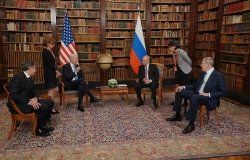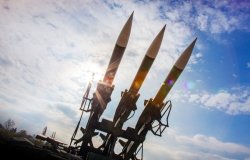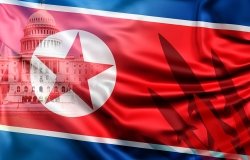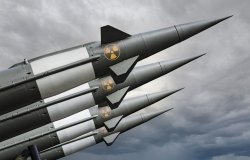Russia’s Nuclear Threats Recast Cold War Dangers: The “Delicate Balance of Terror” Revisited

Viacheslav Lopatin / Shutterstock.com
As the United States convened a meeting of 40 nations in late April to coordinate their military aid to Ukraine, Russia responded with renewed nuclear saber-rattling. Foreign Minister Sergei Lavrov, echoing earlier statements by President Vladimir Putin, charged the United States and NATO with waging a “proxy” war against Russia in Ukraine and asserted that the risk of nuclear war is now “considerable.” While President Biden has called Russian comments about nuclear war “irresponsible,” CIA Director William Burns warned, “Given the potential desperation of President Putin and the Russian leadership, given the setbacks that they’ve faced so far, militarily, none of us can take lightly the threat posed by a potential resort to tactical nuclear weapons or low-yield nuclear weapons.”
Crisis instability over Ukraine is playing out during a period when emerging developments are eroding strategic stability in the nuclear deterrent relationship between the United States and Russia. This confluence threatens to recast and elevate two traditional dangers of the bipolar Cold War era.
Throughout the nuclear age, the U.S. strategy of deterrence has aimed to keep low a low probability event with high consequences. While the probability of Russian nuclear use remains low, the Ukraine War has elevated this risk to a level not seen since the most fraught moments of the Cold War. As Putin warns that any Western interference in Ukraine will be met with a “lightning fast” response from Russia, the crisis contains the risk of escalation—such as a geographical spillover of the conflict beyond Ukraine’s borders.
Crisis stability and strategic stability are linked: strategic stability has been defined by U.S. administrations as the absence of incentives to use nuclear weapons first in a crisis. With the near-total collapse of the arms-control architecture from the last fifty years, the two great powers are now locked in an unconstrained arms race—through their nuclear modernization programs (including the development of a new generation of strategic nuclear systems, tactical nuclear weapons, and hypersonic missiles), as well as the extension of their competition into the emergent domains of cyberspace and outer space.
The first danger of the Cold War being recast and elevated in this emerging strategic environment is the relationship between nuclear deterrence and the possibility for conflict at lower levels on the continuum of military force. After both the United States and the Soviet Union acquired thermonuclear weapons in the early 1950s, British strategist B.H. Liddell Hart speculated, “To the extent that the H-bomb reduces the likelihood of full-scale war, it increases the possibility of limited war pursued by widespread local aggression.” Policy analysts would later refer to this as the “stability-instability paradox”—that strategic stability at the nuclear level could generate instability by encouraging rival powers to pursue tactical gains through non-nuclear means in regions peripheral to the central conflict in what was then called the “Third World.”
But even with the ideological overlay of the Cold War, these stakes were less than vital and the conflicts typically involved one superpower against the proxy forces of the other (e.g., Soviet backing of the North during the Vietnam War, U.S. support for the Afghan Mujahedeen by the Carter and Reagan administrations). These constraints significantly mitigated the risks of escalation. By contrast, the potential flashpoints between the United States and Russia are not peripheral but vital interests.
Russia’s invasion of Ukraine has reset the debate over Vladimir Putin’s revanchist intentions. The scale of the Russian invasion—and the Russian dictator’s initial objective of regime change in Kyiv—accompanied by nuclear saber-rattling is unprecedented and, forebodingly, without geographical limits. The Kremlin has asserted a right to “protect” ethnic Russians and Russian speakers beyond Russia’s borders (which it says numbers some 25 million people) and has even offered citizenship to millions of ethnic Russians living in neighboring former Soviet republics, including the three Baltic states that are NATO members
The second revived danger of the Cold War era are threats to the stability of nuclear deterrence. RAND Corporation strategist Albert Wohlstetter challenged the assumption of an inherently stable nuclear deterrent in a 1959 Foreign Affairs article, “The Delicate Balance ofTerror.” Wohlstetter’s concern then was the vulnerability of U.S. nuclear forces to surprise attack and that in a crisis the Kremlin leadership might perceive an incentive to go first—to launch a preemptive strike. This dynamic led to the Cuban Missile Crisis. The Soviet deployment of medium-range ballistic missiles on Cuba to target the U.S. East coast was a desperate bid to redress the strategic balance with the United States and precipitated the most dangerous crisis of the Cold War. After the profound shock of that near Armageddon, the Soviet Union began to match the U.S. deployment of large numbers of secure second-strike nuclear forces. The crisis highlighted the potentially catastrophic consequences of a “delicate” balance that incentivized one side to go first.
Since the Cuban Missile Crisis, assured retaliation—eliminating incentives for a surprise first strike—has been the sine qua non of strategic stability. The risk for crisis stability is that arms race instability could revive those incentives, making the deterrent relationships more “delicate.” With the advent of new technologies, escalation during a crisis could occur in a non-traditional domain—cyber or space—and could misleadingly be viewed as non-escalatory because it would be non-kinetic. But an inadvertent escalatory spiral could be set off by a Russian cyberattack to interfere with U.S. communications with its nuclear systems or an attack on reconnaissance satellites to blind the United States. Hints of that potentiality are already manifest: Russia conducted an anti-satellite missile test last November and, during the Ukraine war, has carried out extensive cyberattacks, often in coordination with its battlefield operations.
In the Ukraine war, as during the Cuban Missile Crisis, inadvertent escalation remains a major risk. Putin is a risk-taker (whose agents used a military-grade nerve agent in a 2018 assassination attempt on a Russian military defector in Britain) and he is prone to miscalculation. His assumptions going in to Ukraine—that the conflict would be short and decisive, that the Zelensky government would fold quickly, and that the West would be feckless in its disunity—were all miscalculations that ironically led many Western officials and analysts to conclude that he would threaten but not invade.
Given Putin’s propensity for risk-taking and miscalculation, the Biden administration is exploring scenarios in which Russian military “setbacks” and “desperation” (as CIA Director Burns’ warned) lead to the use of chemical or nuclear weapons. Under what U.S. officials describe as Russia’s “escalate-to-deescalate” strategy, Putin might double down in the face of adversity by employing a single weapon for its demonstration effect—to shock the Ukrainian and Western leaderships into acceding to terms favorable to the Kremlin. While the Biden administration has not laid down an explicit deterrent marker specifying the U.S. response, a senior official warned that any Russian use of nuclear weapons would mean “all bets are off”—a tacit signal that such a violation of the nuclear taboo could move the United States and NATO to become directly involved in the war. The Biden administration could strengthen that deterrent message, as Stanford Professor of Political Science Scott Sagan has recommended, by communicating directly to the Russian military that an order from Putin to use a nuclear weapon in Ukraine would be illegal, a violation of the Geneva Conventions, and should not be obeyed.
The challenges of crisis stability to prevent escalation are immediate and urgent even as the near-term prospects for a resolution of the Ukraine war appear remote. The U.S. policy focus should be on preventing inadvertent escalation. Key to that imperative is maintaining an open line of communications with Russia’s military leadership. As a disquieting indicator of the virulent relations between Moscow and Washington, Russia has rebuffed calls from Defense Secretary Lloyd Austin and Gen. Mark A. Milley, the chairman of the Joint Chiefs of Staff, to their counterparts.
Looking to a future beyond the Ukraine war, the Biden administration and U.S. NATO allies are already considering a revived version of diplomat George Kennan’s containment strategy to deter and balance Russian power on its periphery, whether Putin continues to rule in the Kremlin or not. Kennan’s advocacy in 1947 of a strategy of the “long-term patient but firm and vigilant containment of Russian expansive tendencies” resonates today. As during the Cold War, such a strategy should pragmatically allow for engagement with Russia on strategic stability to avoid the prospect of unconstrained and destabilizing arms competition.
In the midst of Europe’s first large-scale conflict since World War II, now is not the time to undertake such a dialogue on the broader challenges of strategic stability with the Putin regime. Whether or not the new state of relations between the United States and Russia should be described as a new Cold War, the two powers have a mutual interest in not revisiting the dangers of that era—ensuring that neither side has a perceived interest in going first and early in a crisis. The nuclear deterrent relationship should never again be “delicate.”
Robert S. Litwak is Senior Vice President and Director of International Security Studies at the Woodrow Wilson International Center for Scholars and author of Managing Nuclear Risks.
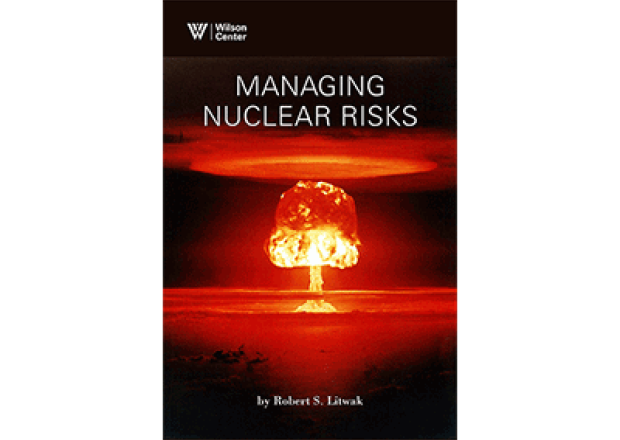
Managing Nuclear Risks
Humanity faces three catastrophic, if not existential, threats—a pandemic, climate change, and nuclear war. In 2020, the coronavirus (COVID-19) pandemic has precipitated a global disruption, while the harbingers of climate change have been manifest in unprecedented extreme weather, wildfires, and polar melting. In contrast, the nuclear threat does not similarly command attention through disruption of our daily lives. Yet a nuclear event would be a global game changer—and the risks of that have risen to their highest level since the Cuban Missile Crisis.
LEARN MOREAbout the Author


History and Public Policy Program
The History and Public Policy Program makes public the primary source record of 20th and 21st century international history from repositories around the world, facilitates scholarship based on those records, and uses these materials to provide context for classroom, public, and policy debates on global affairs. Read more

Nuclear Proliferation International History Project
The Nuclear Proliferation International History Project is a global network of individuals and institutions engaged in the study of international nuclear history through archival documents, oral history interviews, and other empirical sources. At the Wilson Center, it is part of the Wilson Center's History and Public Policy Program. Read more





